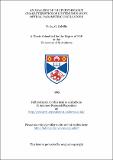Files in this item
An analysis of the performance characteristics of continuous-wave optical parametric oscillators
Item metadata
| dc.contributor.advisor | Dunn, Malcolm H. | |
| dc.contributor.author | Colville, F.G. (FinlayG.) | |
| dc.coverage.spatial | 324 p. | en_US |
| dc.date.accessioned | 2018-07-04T08:48:50Z | |
| dc.date.available | 2018-07-04T08:48:50Z | |
| dc.date.issued | 1995-07 | |
| dc.identifier.uri | https://hdl.handle.net/10023/14887 | |
| dc.description.abstract | This thesis gives a description of studies relating to the development of continuous-wave (cw) optical parametric oscillators (OPOs) and their application to schemes that require high-precision, narrow-linewidth, and frequency-tunable radiation. There are three separate aims to the work presented within this thesis. First, the requirements on pump sources, nonlinear materials, OPO cavity resonances and phase-matching geometries are analysed with a view to operating cw OPOs with stability above threshold. Second, the results of four distinct experiments are outlined, compared to theory, and discussed within the general context of cw OPO development. Third, this thesis is the first comprehensive review of the above-mentioned performance characteristics of cw OPOs, and focuses on their role as optical frequency dividers within frequency synthesis chains spanning the optical spectrum. The modelling sections highlight the importance of cavity resonances in cw OPOs when evaluating pump power thresholds, conversion efficiencies, and mode-selection properties. Simultaneous signal and idler cavity resonances are shown to be critical when relying upon cw laser sources to reach OPO threshold powers. Such arrangements require the use of stable pump lasers and servo-locked OPO cavity lengths to maintain this doubleresonance condition. There is an in-depth analysis of OPO cavity geometries that can generate frequency-stable and continuously-tunable outputs. The selection of nonlinear materials for cw OPOs is also considered with regard to providing signal and idler frequencies in integral-related frequency ratios, thereby satisfying an important requirement within optical frequency division techniques. Four specific experiments were designed to address many of the issues raised within the modelling sections. These experiments realized the following novel arrangements; the use of lithium triborate as a gain material within cw OPOs; a cw OPO which used a pump source operating in the ultraviolet spectral region; the highest frequency output from a cw OPO; a cw OPO which used a tunable pump source operating in the near infra-red spectral region; multiple parameter pump / OPO coarse frequency tuning; a non- degenerate type II cw OPO phase-matching geometry; and a dual-cavity doubly-resonant cw OPO. Other notable features of the experimental designs included stabilized single-frequency output from a single-cavity cw OPO geometry, continuous frequency tuning from a dual-cavity, doubly-resonant OPO resonator, and the general characteristics of low pump power thresholds and moderate conversion efficiencies. An important feature discussed in detail throughout the thesis is the comparison between type I and type II phase-matching geometries. These two cases give rise to different polarization states for the signal and idler fields within OPO cavities. Type II phase-matching geometries are shown, both in theory and experiments, to be preferable to equivalent type I geometries, when considering stable OPO operation, fine frequency tuning, and multiple cavity oscillators. This is so because type II phase-matching geometries, in general, provide significantly different signal and idler refractive indices which in turn yield a considerable mis-match in the signal and idler free spectral ranges. Subsequently this relaxes the stability requirements within single-cavity doubly-resonant OPOs, and allows for polarization separation to form dual-cavity resonators which are vital to the effective operation of cw OPOs within metrology and spectroscopy. The work contained in this thesis forms an integral part of current research in cw OPOs, a field presently enjoying its most productive and prosperous period. The potential incorporation of cw OPOs within frequency synthesis chains is shown to be dependent on the further development of pump lasers and nonlinear materials. In the short term, the actual use of cw OPOs is assessed in relation to more convenient and widespread techniques for converting, comparing, and measuring absolute frequencies. | en_US |
| dc.language.iso | en | en_US |
| dc.publisher | University of St Andrews | |
| dc.subject.lcc | TK7872.O7C7 | |
| dc.subject.lcc | Oscillators | |
| dc.subject.lcc | Optical parametric oscillators | |
| dc.title | An analysis of the performance characteristics of continuous-wave optical parametric oscillators | en_US |
| dc.type | Thesis | en_US |
| dc.type.qualificationlevel | Doctoral | en_US |
| dc.type.qualificationname | PhD Doctor of Philosophy | en_US |
| dc.publisher.institution | The University of St Andrews | en_US |
This item appears in the following Collection(s)
Items in the St Andrews Research Repository are protected by copyright, with all rights reserved, unless otherwise indicated.

